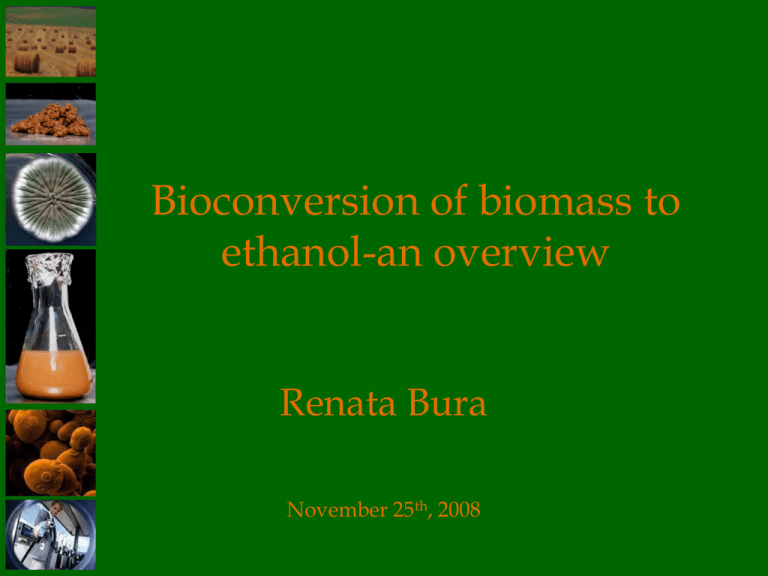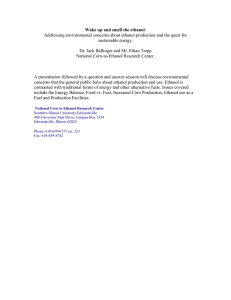Bioconversion of biomass to ethanol-an overview Renata Bura November 25
advertisement

Bioconversion of biomass to ethanol-an overview Renata Bura November 25th, 2008 Overview • • • • • • What is bioconversion? Why bioconversion? Sugar cane to ethanol Corn to ethanol Biomass composition Bioconversion to ethanol process – Pretreatment – Hydrolysis – Fermentation • Pros and cons of bioethanol What is bioconversion? • General: a process which uses biological agents (microorganisms or protein) to transform a feedstock into desirable products. Bioethanol • A chemical/biochemical process by which lignocellulosic materials are converted to ethanol and other coproducts. Bioconversion Pretreatment Hydrolysis Biomass Ethanol Fermentation Distillation Why bioethanol? Ethanol (CH3CH2OH) • Ethyl alcohol, grain alcohol – Clear, colorless liquid • Ethanol made from cellulosic biomass instead of starch crops-bioethanol • Advantages of bioethanol – – – – – Domestic renewable fuel sources Reduces reliance on foreign oil Cleaner fuel sources Easily produced and stored Increases fuel octane number for little cost Energy content Gasoline Ethanol Biodiesel 100% 67% 86% World ethanol production Sugar cane, sugar cane bagasse Sugar cane bagasse Processing Ethanol Sugar cane bioethanol • Brazil produces 3,96 billion gallons of ethanol from sugar cane • Production cost $0.87/gallon, the lowest in the world • Fossil fuel energy used to make the fuel (input) compared with energy in the fuel (output) 1:8 • Green house emission during production and use 56% less compared with gasoline Corn plant Corn kernel (without the fibre)-starch alcohol Corn fibre-lignocellulosic alcohol Corn stover-lignocellulosic alcohol Corn to ethanol • US produces 4,86 billion gallons of ethanol from corn (2006) • Production cost ~$1.09/gallon • Fossil fuel energy used to make the fuel (input) compared with energy in the fuel (output) 1:1.3 or negatives values • Greenhouse gas emission during production and use 22% less compared with gasoline Henry Ford “We can get fuel from apples, weeds, sawdust, almost anything….. And it remains for someone to find how this fuel can be produced commerciallybetter fuel at a better price than we now know.” Henry Ford Why bioconversion? • Energy – An alternative source of energy for the transportation sector produced locally • Air pollution – Reduction in greenhouse gas emission • Waste elimination – Elimination of problems with field burning/incineration, stockpiling, etc. • Socio/economical benefits – Creation of new jobs, rural development Possible lignocellulosic feedstocks • Agricultural residues (corn stover, corn fibre, wheat straw, rice straw) • Wood residues • Paper waste • Municipal solids waste Biomass composition Cellulose Hemicellulose Lignin Bioconversion of biomass to ethanol (pretreatment) Liquid Pretreatment phase Sugars Ethanol Fermentation Biomass Lignin Recovery Solid phase Cellulose Hydrolysis Fermentation Sugars Ethanol Pretreatment-”disruption” • Helps in separation of main biomass components (cellulose, hemicellulose and lignin) • Increase available surface area • Reduce particle size Steam explosion • Treatment of biomass with high-pressure steam for a short period of time followed by sudden decompression • Acid (H2SO4, SO2) impregnation of biomass increases SE efficiency • Typical conditions: – Temperature: 170-250oC, 338-482 F – Time: 10sec-10min Steam gun Fill valve Receiving Karin vessel Receiving vessel Steam valve Blow valve Pretreated corn stover Bioconversion of biomass to ethanol (hydrolysis) Liquid Pretreatment phase Sugars Ethanol Fermentation Biomass Lignin Recovery Solid phase Cellulose Hydrolysis Fermentation Sugars Ethanol What are cellulases? • Produced by many strains of bacteria and fungi • Catalyzes the depolymerization of cellulose chains – Endoglucanases – Exoglucanases – β-glucosidases Cellulases Binding domain Endoglucanases (EG) cutting the cellulose chains randomly Catalytic domain Cellobiohydrolyses (CBH) cutting cellobiose units of the ends of the cellulose chains Bioconversion of biomass to ethanol (fermentation) Liquid Pretreatment phase Sugars Ethanol Fermentation Biomass Lignin Recovery Solid phase Cellulose Hydrolysis Fermentation Sugars Ethanol Fermentation • Defined as: Cellular metabolism under anaerobic conditions (absence of oxygen) for the production of energy and metabolic intermediates • Many organisms can “ferment” (i.e., grow anaerobically) • Not all produce ethanol as an end-product of fermentation Strain selection • Choice of microorganism for ethanol production has traditionally been a Yeast • Yeast: – Single cell microorganism – Fungi – Facultative anaerobe • Most common industrial fermenter is Saccharomyces cerevisiae (baker’s or brewer’s yeast) • Why? Fermentation Conversion factor 0.51 1g/L of glucose: 0.51g/L ethanol (maximum) Biofuels-comparison Production (billion gallons) Production cost ($) Energy balance GHE reduction (%) Corn 4.86 1.09 1.3 22 Cane 3.96 0.87 8.0 55-90 Lignocellulose NA NA 2-36 91 Biodiesel 0.50 NA 2.5 68 Alternative options??……. Flexible-Fuel Vehicles (FFV) • Use E85 (85% ethanol and 15% gasoline) • Cost of FFV is similar to traditional gasoline vehicle • 1gallon of E85 provides the same energy as 0.72 gallons of gasoline (lower E content) • Special materials required for fuel lines, hoses, valves, gaskets, fuel tank (corrosive ethanol) • Washington state more than 35, 000 of FFVs (U.S. over 4 million FFVs) – Ford Focus, Chrysler Sebring, Dodge Stratus, Dodge Caravan, Chevrolet Avalanche Summary • • • • • • What is bioconversion? Why bioconversion? Sugar cane to ethanol Corn to ethanol Biomass composition Bioconversion to ethanol process – Pretreatment – Hydrolysis – Fermentation • Pros and cons • FFV References • • • • • • • • • • • www.ento.vt.edu/~salom/SPBbiology/blustain.html www.pherotech.com/new_products.html www.dnr.wa.gov/../issues/2002issues.html www.laco.ufpe.br/prh28/ www.bio-pro.de/en/region.rhein/magazin/01440 www.maize.agron.iastate.edu/corngrows.html www.nrel.gov www.energy.iastae.edu www.usda.gov/wps/portal/usdahome www.ethanol-gec.org/clean/cf13.htm www.eere.energy.gov/biomass/






